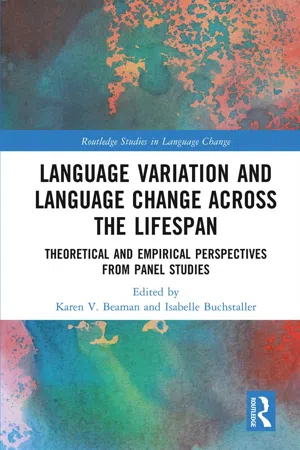
Language Variation and Language Change Across the Lifespan
Theoretical and Empirical Perspectives from Panel Studies
- 286 pages
- English
- ePUB (mobile friendly)
- Available on iOS & Android
Language Variation and Language Change Across the Lifespan
Theoretical and Empirical Perspectives from Panel Studies
About this book
This volume brings together research on panel studies with the aim of providing a coherent empirical and theoretical knowledge-base for examining the impact of maturation and lifespan-specific effects on linguistic malleability in the post-adolescent speaker. Building on the work of Wagner and Buchstaller (2018), the present collection offers a critical examination of the theoretical implications of panel research across a range of geographic regions and time periods. The volume seeks to offer a way forward in the debates circling about the phenomenon of later-life language change, drawing on contributions from a variety of linguistic disciplines to examine critical topics such as the effect of linguistic architecture, the roles of mobility and identity construction, and the impact of frequency effects. Taken together, this edited collection both informs and pushes forward key questions on the nature of lifespan change, making this key reading for students and researchers in cognitive linguistics, historical linguistics, dialectology, and variationist sociolinguistics.
Frequently asked questions
- Essential is ideal for learners and professionals who enjoy exploring a wide range of subjects. Access the Essential Library with 800,000+ trusted titles and best-sellers across business, personal growth, and the humanities. Includes unlimited reading time and Standard Read Aloud voice.
- Complete: Perfect for advanced learners and researchers needing full, unrestricted access. Unlock 1.4M+ books across hundreds of subjects, including academic and specialized titles. The Complete Plan also includes advanced features like Premium Read Aloud and Research Assistant.
Please note we cannot support devices running on iOS 13 and Android 7 or earlier. Learn more about using the app.
Information
Part I
Revelations from Past Trend and Panel Studies
1The Beginnings of Panel Research
1.1 Introduction
1.2 Data and Methods in Early Panel Research
1.2.1 The Eskilstuna Community
Table of contents
- Cover
- Half Title
- Series Page
- Title Page
- Copyright Page
- Dedication
- Contents
- Figures
- Tables
- Contributors
- Acknowledgements
- Panel Studies of Language Variation and Change: Theoretical and Methodological Implications
- PART I: Revelations from Past Trend and Panel Studies
- PART II: Insights in the Analysis of Intra-Speaker (In)Stability
- PART III: A Glimpse of the Past: Panel Research from Archival Material
- PART IV: New Methodological Approaches for Lifespan Studies
- PART V: Future Directions For Panel Reserach
- Index